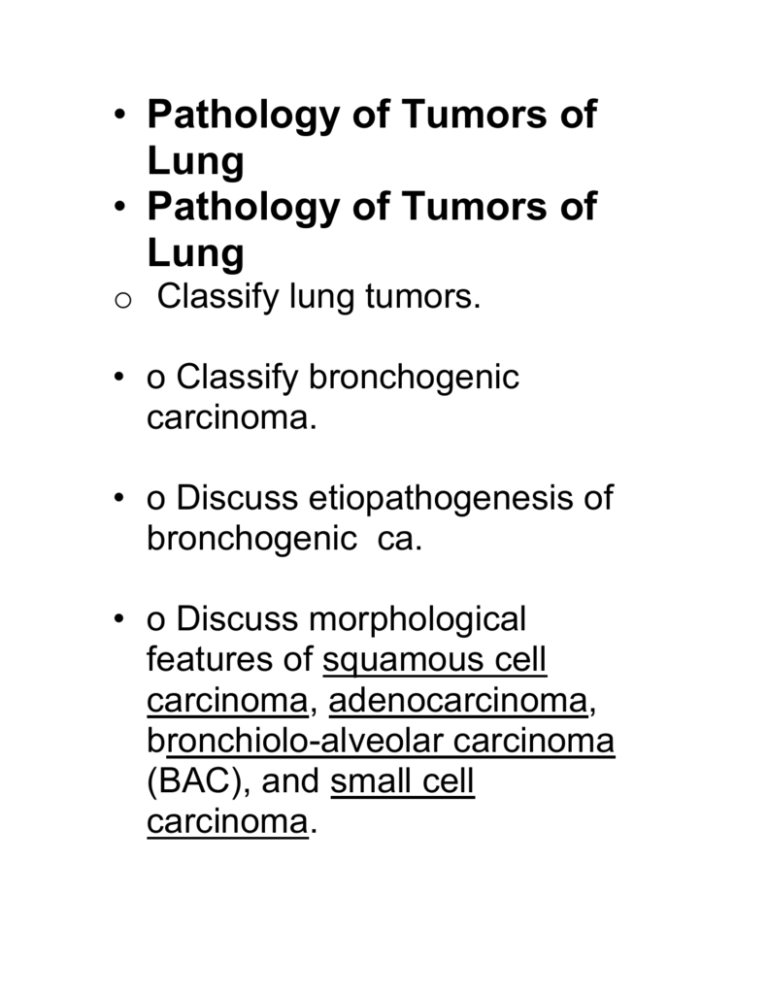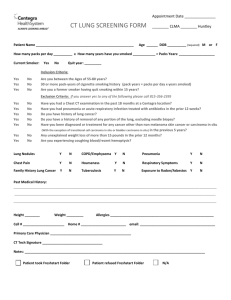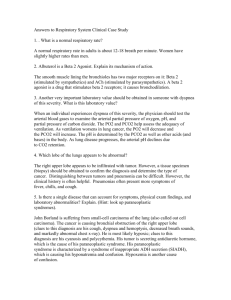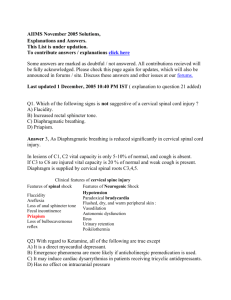Pathology of Tumors of Lung Pathology of Tumors of Lung
advertisement

• Pathology of Tumors of
Lung
• Pathology of Tumors of
Lung
o Classify lung tumors.
• o Classify bronchogenic
carcinoma.
• o Discuss etiopathogenesis of
bronchogenic ca.
• o Discuss morphological
features of squamous cell
carcinoma, adenocarcinoma,
bronchiolo-alveolar carcinoma
(BAC), and small cell
carcinoma.
• o Enlist clinical features, spread,
and complications of lung
malignancies .
• Lung tumors
• Is the commonest fatal tumor in
men.
• > 1970 a lot of biological data
produced (IHC, EM, PCR)
• Incidence rises with Age, between
40 – 70 yrs.
• Associated with cigarette smoking.
• Many Histologic types with varying
degrees of malignancy, ranging
from: Entirely benign to extremely
malignant.
• {Central OR peripheral} { Bronchial
OR Bronchio-alveolar}
• Histologic Classification of Lung
and Pleural Tumors
• Benign
• Mucinous (“colloid”) adenocarcinoma
• Classification of
Bronchogenic
carcinoma
• Four major Histologic
subtype:
• Bronchoalveolar ca (BACs) is
subtype of Adenocarcinoma.
• All NSCLC are genetically distinct
&surgery is curative, if limited to
the lung. SCLC needs
chemotherapy.
• Etio-pathogenesis.
• well-known lung carcinogens:
• 1. Genetic abnormalities:
• Accumulation of genetic abnormalities that
transform benign bronchial epithelium to
neoplastic tissue- NSCLC
______________________________
_________________
• 2.Tobacco-cigratte Smoking. 87%
of lung ca. (tenfold risk)
• ______________________________
____________________3.Industrial
& occupational Hazards
exposures: a)Ionizing radiation , b)
Hiroshima and Nagasaki atomic bomb blasts.
c) uranium miners.
d)Asbestos.______________________
___________
4.Air Pollution: a)Atmospheric pollutants.
b) Indoor air pollution (GAS). c) Radioactive
decay products
______________________________
__________________
5. Precursor Lesions: a)-Squamous
metaplasia, b) Squamous dysplasia and
carcinoma in situ, c) Atypical adenomatous
hyperplasia, d) Diffuse idiopathic pulmonary
neuroendocrine cell hyperplasia.
• 1.Tobacco Smoking.
• Environmental tobacco smoke
induced risk of mutation.
• Well known carcinogen- depend
on:
• (1) The amount of daily smoking,
25 cig\day
• (2) The tendency to inhale,
• (3) The duration of the smoking
habit.
• Histologic Outcome of smoking
changes in the lining epithelium of the
respiratory tract. These sequential
changes have been best documented
for SCC & other type.
• Other type of cancer (mouth,
pharynx, cervix, etc..)
• Nonsmoking spouses of cigarette
smoker (passive smoking).
• Morphologic of Lung ca.
• Types:
• ADC , SCC, LCLC, SCLC
• Gross appearance:
• Grayish\whitish.
• Start small – intra-luminal mucosa firm
nodule.
• Large mass develop central necrosis&
cavity.
• Central (SCC, SCLC) or peripheral
(ADC,LCLC)
•
• Pattern of local spread:
• Invade adjacent structures (Lung tissue,
vessels, lympahtic, nerves) extended to:
• a)Pleural cavity. b) chest wall ,c) Intarthoracic structures.
• Mode of distal metastasis:
Adrenal,liver,brain,bone
• (1) Haematogenous (2) Lymphatic
• Morphologic features
• 1. Adenocarcinoma
(ADC): “common type”
• Commonly peripheral lesion,
appears as scar.
• >> Non-smoker + >> in female:
• Common features
• No precursor- Genetic mutations(EGFR,KRAS)
• Smaller in size than other type
• Grayish\whitish
• Early metastasis.
• Respond to treatment targeting
epithelial growth factor receptor (EGFR).
• Histologic types:
• (a) Acinar, (b) Papillary, (c)Solid. (d)
Mucinous
Bronchoalveolar ca
(BACs):
• “sub-type” of adenocarcinoma.good prognosis
• Location: Commonly peripheral
lesion or Multiple.
• Single nodule or multiple gives
pneumonia-like feature
• Grows along per-existing
structure& preserve alveolar
architecture. No destruction of
alveolar structure.
• Histologic types:(1)Mucinous
(2)Non-mucinous type.
• 2. Squamous cell ca.
• Precursor: Squamous metaplasia
Dysplasia CIS.
• Location: Commonly major bronchi
(central).
• Spread: local\node\ metastasis
• Large tumor- necrosis& cavity.
• Histologic types:
• (1) Well (2) Moderate (3) Poor
• Sputum cytology• Paraneoplastic syndrome=
• Hypercalcaemia (PTH-related protein)
3.Small cell lung carcinoma
(SCLC)= (Oat)
• Highly malignant,- high grade, a
distinctive cell type.
• Neuroendocrine nature.
• Paraneoplastic syndrome.(++)
• No precursor.
• Poor prognosis
• Location: major bronchi+ Endo-bronchial
(central) more > in the periphery.
• Tumor cells- small size, rounded >
lymphocyte size.
• Nuclei -salt-and-pepper" chromatin Mitotic
figures- Necrosis.
• EM - neurosecretory granules.
• Spread: metastasize widely.
• Never Localized- No surgical option
•
Paraneoplastic syndrome
• 4.Large cell lung carcinoma
• Undifferentiated heterogenous malignantoriginate from transformed epithelial cells.
• Less likely to produce para-neoplastic
syndrome
• Diagnosis of exclusion.
• Location: peripheral zone> central
• Tumor cells- large nuclei, prominent
nucleoli, and a moderate amount of
cytoplasm
• Pattern: organoid nesting, trabecular,
rosette-like, and palisading patterns.
• immunohistochemistry or EM- for
neuroendocrine feature.
• Signs and Symptoms
Of Lung Cancer
• Complications
• 1. Local aggressiveness (airway
obstruction, dysphagia, pleural
effusion, pericardial effusion,
hoarseness, vascular obstruction,
nerves involvement).
• 2. Distal metastasis (Adrenalliver-brain and bone).
• 3. Para-neoplastic syndrome
• Paraneoplastic syndrome
• is a clinical syndrome
involving non-metastatic
effect or symptoms that is the
consequence of cancer in the
body but:
• - Not a mass effect- local
presence of cancer.
• These phenomena are mediated
by humoral factors (by
hormones or cytokines)
excreted by tumor cells or by an
immune response against the
tumor.
• Paraneoplastic syndrome
• 1. Hypercalcaemia –
(production of PTH)- SCC
• 2. Calcitonin production
= hypocalcemia
• 3. Cushing syndrome.
(Ectopic corticotropin)-ACTH
• 4. Gonadotropins,
causing gynecomastia
• 5. SIADH-inducing hyponatremia
vasopressin SCLC
• 6. Mythenia syndrome
• 7. Clubbing finger
• 8. Haematologic manifestation
- (ADC)
•
• Diagnostic Tests
•
•
•
•
•
•
CXR
CT Scans
MRI
Sputum cytology
Fibreoptic bronchoscopy
Transthoracic fine needle
aspiration
• The end
???
• Case No.1
• A 50-year-old man has developed
truncal obesity, back pain, and
skin that bruises easily over the
past 5 months. On physical
examination, he is afebrile, and his
blood pressure is 160/95 mm Hg. A
chest radiograph shows an ill-
defined, 4cm mass involving the
left hilum of the lung. Cytologic
examination Of bronchial washings
from bronchoscopy shows round
cells that have the appearance of
lymphocytes but are larger. The
patient is told that, although his
disease is apparently localized to
one side of the chest cavity,
surgical treatment is unlikely to be
curative. He also is advised to stop
smoking. Which neoplasm is most
likely to be present in this patient?
• Case No.2
•
A 64-year-old man, who is a chain
smoker, sees his physician
because he had had a cough and a
5-kg weight loss over the past 3
months. Physical examination
shows clubbing of the fingers. He
is afebrile. A chest radiograph
shows no hilar adenopathy, but
there is cavitation within a 3-cm
lesion near the right hilum.
Laboratory studies are
unremarkable, except for a calcium
level of 12.3 mg/dL, phosphorus
concentration of 2.4 mg/dL, and
albumin level of 3.9 g/dL.
Bronchoscopy shows a lesion
almost occluding the right main
stem bronchus. A biopsy is
performed. What is the diagnosis?
• Case No.3
•
A 57-year-old woman comes to her
physician because she has had a
cough and pleuritic chest pain for
the past 3 weeks. On physical
examination, she is afebrile. Some
crackles are audible over the left
lower lung on uscultation. A chest
radiograph shows an ill-defined
area of opacification in the left
lower lobe. After 1 month of
antibiotic therapy, her condition
has not improved, and the lesion is
still visible radiographically. CTguided needle biopsy of the left
lower lobe of the lung is
performed, and the specimen has
the histologic appearance shown
thickened alveolar wall with
preserve alveolar architecture.
Which neoplasms is most likely to
be present in this patient?







